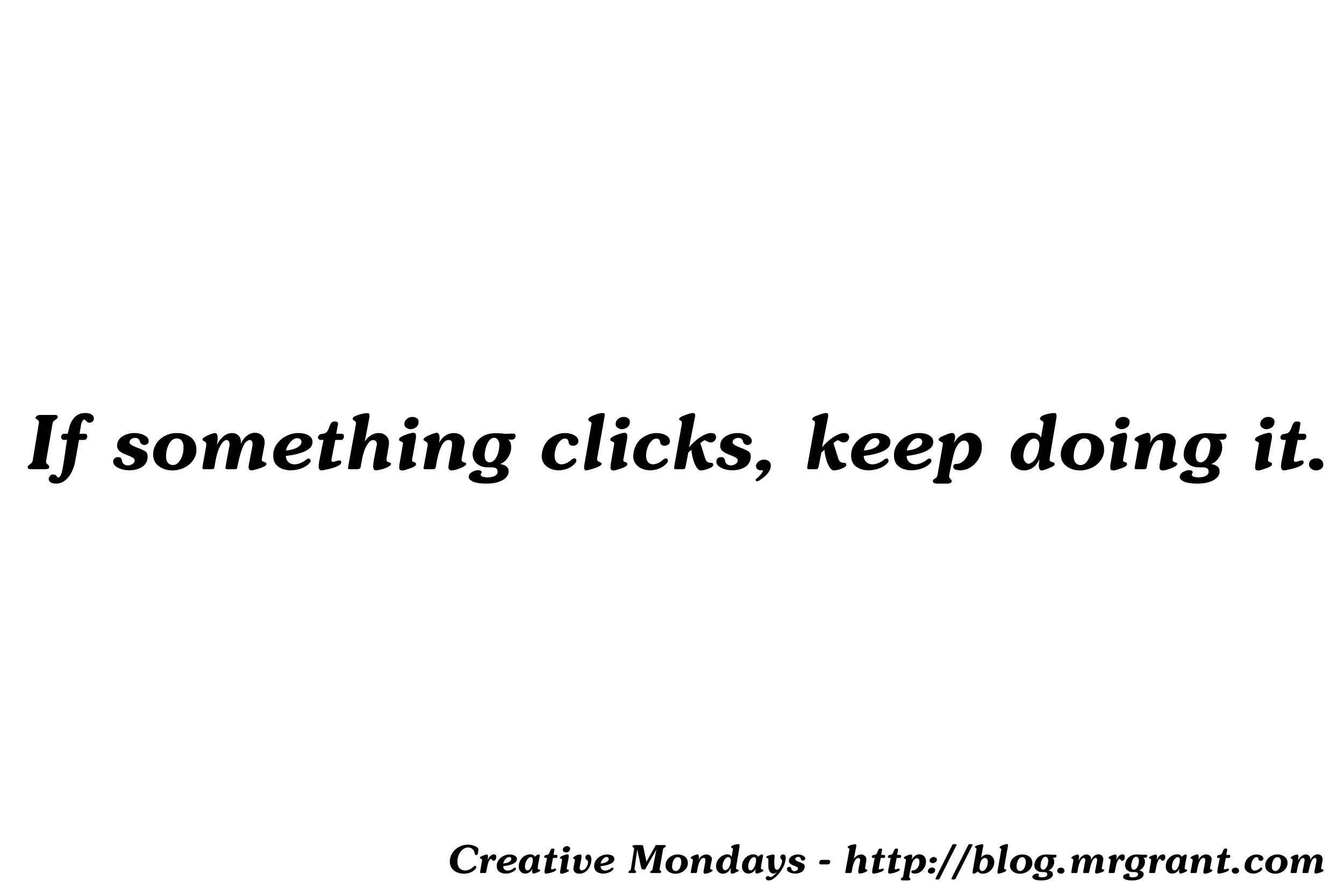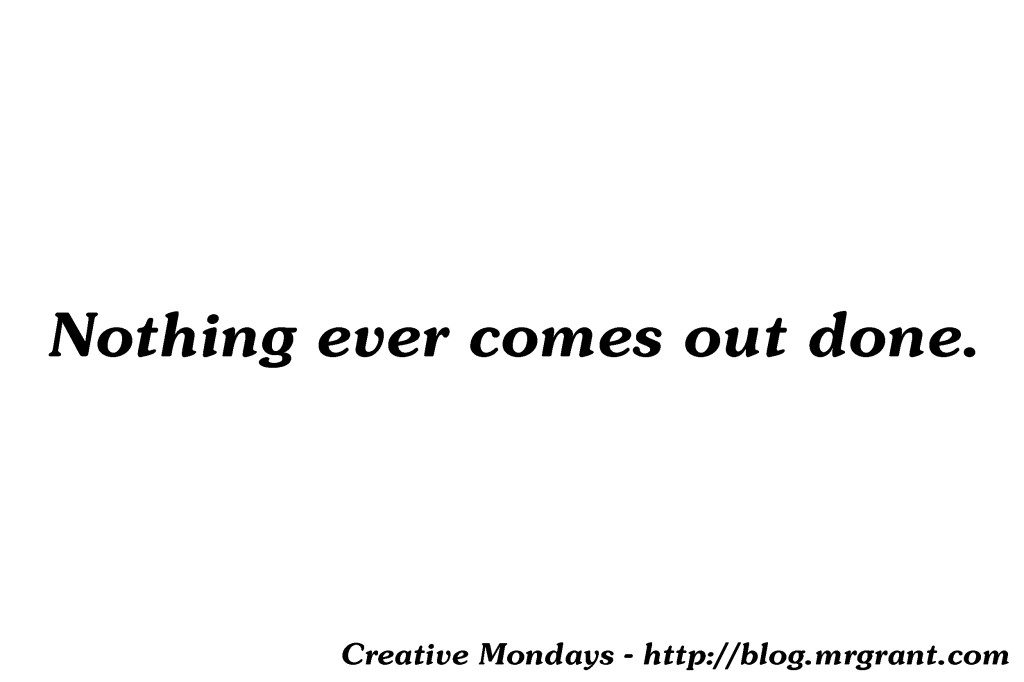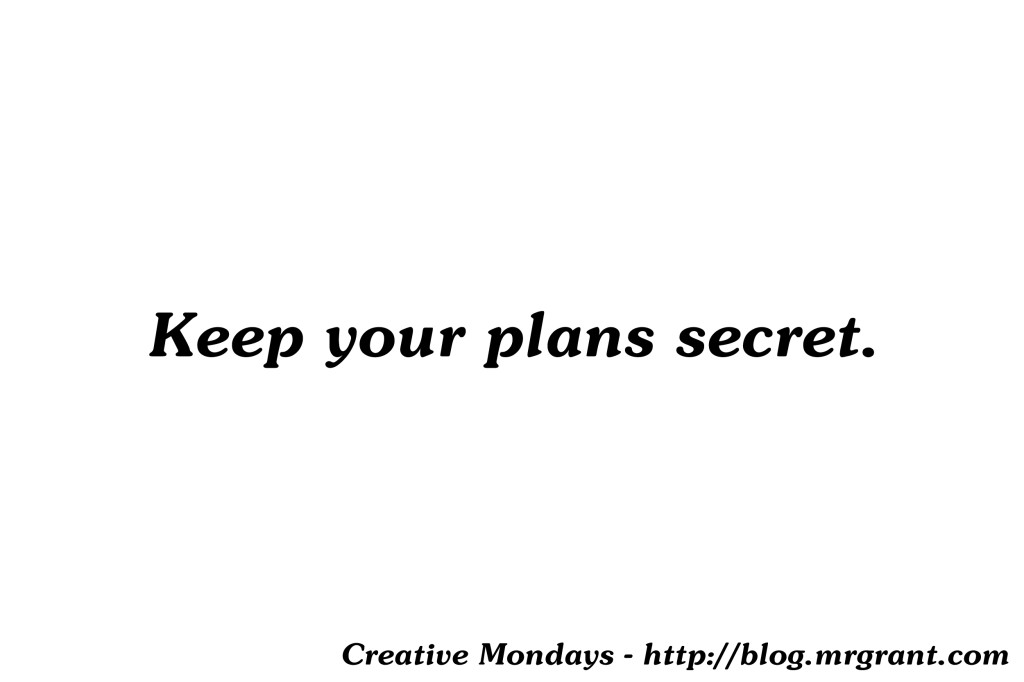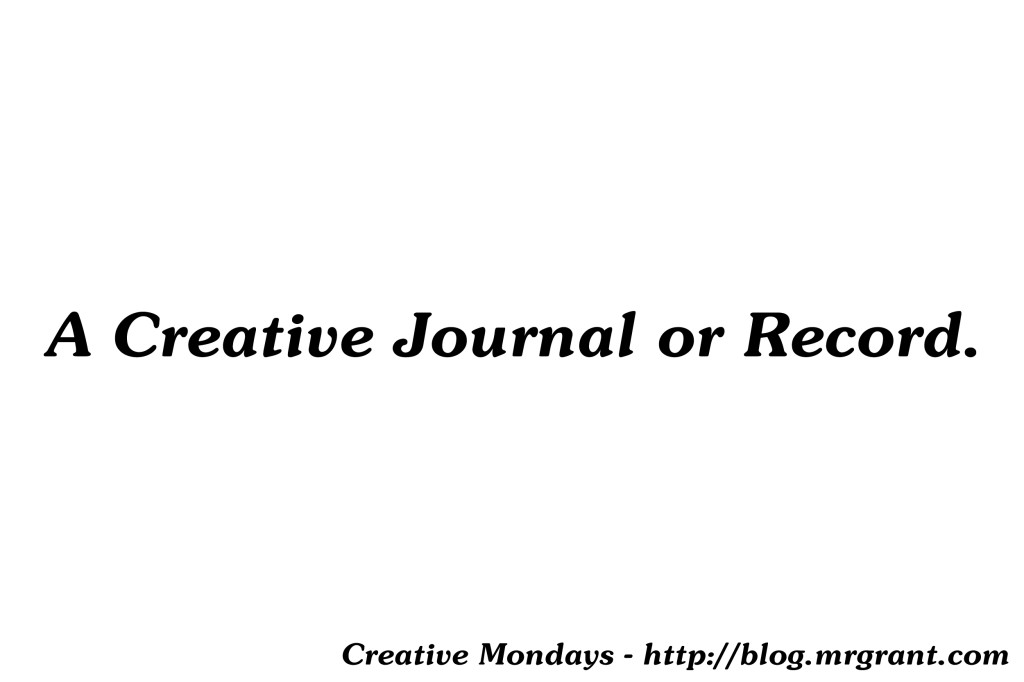Tag: painting
Creative Mondays #011 – If something clicks, keep doing it.

When I began training to be in The Jim Henson Company’s Puppet Up, part of the training was improv classes. After taking those classes for a while, I started taking classes outside of Henson, through The Imrpovatorium. Most of my classes were with Patrick Bristow but I had a few other teachers as well. One class I took was a long form improv class with Ted Michaels. Ted is a brilliant improviser and he is also a member of Puppet Up. Ted is a great teacher and knows a lot of great structures to help drive home the core concepts of improv.
I don’t remember the exact name, but one of the structures we did really hit me as being funny and, as I was thinking back about it today, the principles of it can be applied to creativity. The improv scenes started out just like most other improv scenes. Two people got a suggestion and then began the scene. The rule of this game was to go through the scene as normal until the first big, whole audience, laugh. Then, whatever it was that got that laugh, the two improvisers just keep doing that. The point being that if you keep following that first big laugh, most of the time the scene will continue to be really, really funny. I’ll give you an example.
My friend Chris and another improviser were doing a scene that involved them getting into a car. Once inside the car, Chris made a move to roll down the car’s window. Of course, he was ‘space-working’ or miming it because there wasn’t a car on stage. So Chris made the move to roll down the window but his move was just really weird and not how you would go to roll down a real car window. It was funny because the audience immediately thought, “What kind of crazy wind controls does this car have?” That move got a big laugh.
So Ted said, “Okay, the scene is now about this ‘awkward space-work’ car.”
So Chris and his partner just went on with the dialogue as normal, but everything in the car, turning on the radio, opening the sunroof, pushing in the cigarette lighter, became these really big awkward physical movements. The scene was so funny. As the class continued, time and time again it was proven that if you just kept following that one thing that tickled the audience, the scene will succeed. Of course there were exceptions to the rule, but for for the most part, it worked.
Now, another improv teacher I’ve had would agree to an extent. I believe he would say you should pursue what the audience feels is funny, yes, but be aware when they are ready to move on to something new. Then look for the next thing and follow that.
I think this theory or pursuing what ‘clicks’ with the audience can be applied to creative work as well.
If you find that you create a piece of art that really clicks with your audience, follow it. Keep creating in that manner. Now I’m not saying paint the same painting over and over again, but if you find a style that hits with your audience, keep creating in that style. If you’re a writer and a story or book hits, write another with the same characters or in the same universe. If a sculpture you create is a hit, create in the same style for the next one. Follow what clicks with your audience. I’m also not saying never create in another way again, that would be boring. But if you find something that works, go with it until it doesn’t work anymore and then try something else.
I can point to an example of this in The Radio Adventures of Dr. Floyd. In 6 seasons of the show we followed the same ‘time travel’ formula. Dr. Steve wanted to steal historical artifacts and Dr. Floyd tried to stop them. After six seasons I wanted to try something else. Shake up that formula a little. So I created a season long storyline where Dr. Floyd and Dr. Steve got trapped inside classic literature. Now, I think these were some of our most fun shows and showed that the Dr. Floyd characters could still exist in another format. Some in the audience didn’t think so. While many folks loved Season 7, we got plenty of feedback from folks who missed the time travel formula we had done over the previous seasons. So, you’d better believe we brought it back for what was the eight and final season.
Dr. Floyd really clicked with people and I followed it until it was impossible to do so anymore due to issues that arose between myself and the other co-creator of the characters. Since then, I’ve created other similar style projects and some of that audience stayed with me. True, many want Dr. Floyd to return, but that’s just not possible now. But those who like the way I produced audio drama have followed and, I hope, they aren’t disappointed as I’m still creating in the same style. I’ve set up Saturday Morning Theatre as sort of a testing ground where I can produce different types of shows and if one of those shows really clicks, I can run with it and produce more. The Tales Deputy Guppy seems to have a pretty good fan base, so there will definitely be more episodes of that. The Adventures of The Thunder Crester got sort of a lukewarm response, so I may make a few more episodes to wrap up the storyline, but I probably won’t be producing more seasons of it.
If something clicks with your audience, keep doing it.
—
Have you ever had something click with your audience? If so, what did you do? Did you follow it or try something different? Let me know in the comments below.
Creative Mondays #007 – Nothing ever comes out done

Last week I wrote about the concept of: Don’t do what you don’t want to do. It was an idea that had struck me when I went to see Joel Hodgson’s Riffing Myself show last weekend. I had two more thoughts from that show and I want to touch on the next one this week.
During Joel’s show he spoke a lot about the things that influenced him growing up as a kid. He talked about being captivated by the artwork of Roger Dean. If you don’t know, Roger Dean was an artist who is probably best known for doing the artwork for the covers of several albums for the band Yes. Those far out, alien looking, landscapes? Those were by Roger Dean. When Joel was younger Roger Dean released a book called Visions. It collected a bunch of artwork to that point in his career, but not only did the book include the artwork, it also showed the process of the artwork. From pencils sketches, through refinements, to the finished project, Roger showed step by step how things were made. Roger Dean also introduced Joel to the concept of kitbashing, or taking different parts from different model kits and combining them together to create something new. A technique Joel would later use to build robots for a certain television show.
One part of the book that really captured Joel’s attention was a page where Roger showed the process he took to create the logo for the band Yes. The swooping, sort of intertwined, logo that the band still uses to this day. That page, that showed the evolution of the logo from start to finish in a series of different photos of drawings was a lightbulb moment for Joel. Until that point, he had never realized that finished products aren’t just instantly created.
During his talk, Joel said the phrase, “If it’s not perfect, it’s not done.” I later talked to him about this statement and clarified clarified a bit saying that nothing comes out perfect the first time. It takes work to get something right. There’s a lot of trial and error in working to get something right.
I was happy for this clarification because the word ‘perfect’ opens up a lot of troubling doors, in my opinion. I’ll write about the ‘quest for perfection’ in the weeks to come. But the point Joel is making here is, as I said above, art just doesn’t come out perfect immediately.
If you’re writing a song, very rarely is it finished on first pass. Same with writing a book, play or script. Painting, sculpting, the list goes on. Creating art doesn’t just come out as a finished product.
I will take this stance however, it’s it okay to continue to create as you are refining your process. My example for that is my podcast The Radio Adventures of Dr. Floyd. If you listen to first season episodes and compare them to season eight episodes there is a world of difference. The pacing is tighter, the sound quality is better, it’s just an overall better show. That’s because there was a huge learning curve in how to edit and create an episode over those eight seasons. I learned a lot about editing audio and it shows. Also I think my writing improved from season one to season eight.
In sticking with the topic of ‘nothing comes out done,’ I wouldn’t say those season one episodes weren’t done. I worked on them just as hard as I did season eight episodes. I was just better at the work in those later years.
I think the takeaway here is that it takes some time to create art. Nothing ever comes out done
—
Is the idea of ‘nothing ever comes out done’ true in your creative work? How long does it take for you to finally say, “That’s done, I’m moving on to the next piece?” Let me know in the comments below.
Creative Mondays #005 – Keep you plans secret.

Keep your creative plans secret until they are completed.
This is a tough one and, though I believe in it and will explain why, it is a hard one for me to do.
The main reason you should attempt to keep your creative plans secret until you have completed them is because if you tell them to other people they will, no matter how well meaning they are, offer their opinion on your plans. You will get no end to unsolicited feedback on your idea.
“That’s a great idea!” they’ll inevitably start, but then they’ll continue, “You know what you should do…”
Now if the sentence above is coming from someone you admire or respect or whom you are asking for advice, that’s fine. If you admire or respect them or asked for their advice, that’s great, listen to their suggestions. Remember, though, these are suggestions.
The focus of this entry is about telling friends, peers, family about your plans. These folks like (love) and respect you and they think they’ll be helping you out by offering their advice. What happens then is that once you begin creating your art, the ‘advice’ that these people starts creeping into your head and you begin second guessing yourself.
“Maybe so and so was right. Maybe I should do it their way instead of the way I had planned.”
This becomes dangerous because suddenly the your art is not your own. It has become a community project. Nothing against community projects, they are great, but this is YOUR art project.
This is the number one reason I try to keep my ideas to myself. Notice I say try. It’s extremely hard to do. The main reason for blabbing is I get really excited about an idea and I want to share it with the world. I need to realize that it’ll be much better (and save me much second guessing) if I tell people after it’s done. Or better yet, show them. Writers often say ‘show don’t tell.’ I think that’s a great bit of advice that all artists can take about their own work. Get it done and THEN show somebody.
Another reason to keep mum about a project is because sometimes I talk so much about a project I never really get around to actually working on it. I know it sounds weird, but there’s something in the brain that will trick you into thinking, “Well I’ve talked about it so much, I must have done it.” When, in actuality, you haven’t done anything. Almost as if a little bit of the creative desire in you escapes each time you say something about it until you have no creative desire left to work on the project.
Finally, there is the thought of sharing your ideas with others before you do them and then someone steals your idea. I don’t think this happens as much as people are afraid it does, but it does happen, so it’s another good reason to just keep quiet about your project.
As artists, our main drive in life is to create something and then share it with the world. We should just think twice about sharing them before we’ve even begun creating them.
—
Do you fall into the same pitfalls as me and blab your project to everyone around you? Or do you thrive on getting other people’s opinions about your project? Let me know in the comments below.
Creative Mondays #004 – A Creative Journal or Record.

In 2010, I learned about Jim Henson’s Red Book. The Red Book was a journal that Jim Henson started in 1965 where he wrote down all the significant events that had happened in his life up to that point and then he continued to keep updating the journal from then on. He wrote entries all the way through 1988. There’s a fun website set up at www.JimsRedBook.com where you can see what Jim wrote down for that day in his journal. Jim wrote entries for major events in his life, both creative and personal and it’s an amazing record of some of the amazing things Jim accomplished in his life. A bulk of the entries were accumulated into a book called Imagination Illustrated which is well worth a read. Or two.
After discovering this fact about Jim Henson, I really liked the idea of starting a creative journal. I’m not talking about a journal where I wrote down ideas, though I have one of those as well. I’m talking about a journal where I write down, daily, what creative things I have worked on during the day. I guess the real term would be a Creative Record but I’m just comfortable using the word record.
So I bought a hardbound Moleskin, lined notebook and began keeping the journal. At the end of each day, before bed, I write down the creative things I did that day. I just write a simple line for each thing with the date. Here’s an example of an entry.
8/2/2011 − 2 Milk Minimum show at Flappers
– Continued work on Astral Factor for Cinematic Titanic.
– Met with Leslie Carrara- Rudolph about NorCal Shows
– PuppetUp Rehearsal at Henson.
That’s it. Just a line for each item and I do this every day. I started October 6, 2010 and have made entries for just about every day since then because of my goal of doing at least ONE creative thing everyday. With two minor exceptions, one being breaking my arm, the other recording the day I met someone who influenced me greatly, I only put creative things in this journal. It’s a fantastic record I can look back through to see what I was working on then and what I’m working on now.
It’s also a super great motivator to keep creating. I look forward to writing down the creative things I did each day and I always make sure there is at least one thing I can write down before going to bed. And I do it EVERY day. If I’m on the road or on vacation, I keep a list in my phone and the moment I’m back I write down all the creative things I did while away.
I finished my first creative journal on November 7, 2013 and I started a new one. I’m really proud of that first one as it is a three year, one month and one day record of everything I creatively worked on. It is SUPER fun to go back through and look at what I was doing on a particular day. It was so much fun to start a new one, what a great feeling of accomplishment. And even though I’m only a little ways into my second one, I’m already looking forward to the third!
So try out a creative journal. It doesn’t have to be a physical journal either. It could be a word processor file or a Google Doc you could update from anywhere. But give it a shot and see if it helps motivate you into being creative each day.
Now, if you’ll excuse me, I’m off to enter writing this blog post into my creative journal!
—
Have you been doing something similar to this already? If so, let us know what it is and what your process is in the comments below.